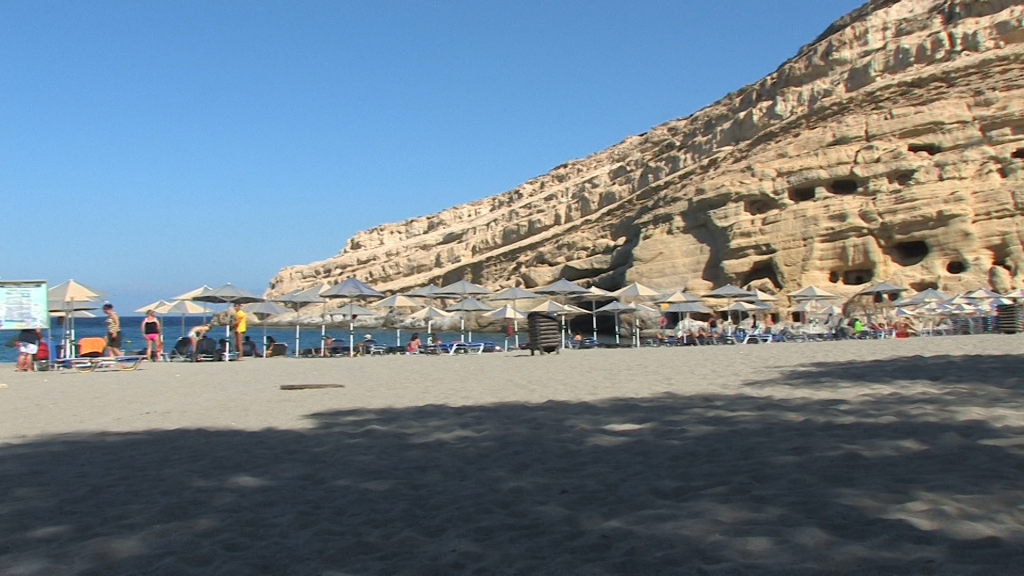Matala Caves, a mesmerizing labyrinth of ancient dwellings etched into the rocky cliffs of Crete, Greece, is a living testament to the intertwining of human history and natural beauty. This archaeological marvel, situated on the southern coast of the island, beckons travelers and dreamers to explore its enigmatic chambers that once cradled civilizations of the past.

The caves, their name resonating like an echo from the distant past, have witnessed the ebb and flow of countless generations. Carved into the soft limestone cliffs, they served as humble abodes, sanctuaries, and even burial sites. These hollows in the rock, each with its unique character, create a landscape of mystery and wonder that has captivated the imagination for centuries.
The origins of the Matala Caves trace back to the distant epochs of prehistory. Archaeological evidence suggests that these caves were inhabited as early as the Neolithic period, a testimony to the resourcefulness of our ancient ancestors. These early inhabitants, drawn by the protective embrace of the cliffs and the proximity to the azure waters of the Mediterranean, sought shelter within the heart of the earth.
The true historical significance of the Matala Caves came to light during the Roman and later periods. In the 1st century BCE, these caves transformed from mere shelters into tombs for the deceased. The deceased were interred within rock-cut chambers, creating a necropolis that held the memories and stories of lives long gone. The façade of these caves, meticulously carved with entrances resembling the fronts of houses, speaks to the cultural fusion that marked this era.
In the decades that followed, the Matala Caves underwent a fascinating metamorphosis. The arrival of a diverse array of civilizations, including the Romans and Byzantines, imparted layers of history to the caves. The intricate carvings and inscriptions that adorn some of the chambers whisper tales of devotion, while others offer glimpses into the daily lives of those who once called these caves home.
Matala Caves achieved a renewed prominence in the 20th century, thanks in part to the counterculture movement that embraced them during the 1960s and 1970s. The caves, once ancient tombs and dwellings, became a haven for free spirits and artists seeking refuge from societal norms. The bohemian lifestyle of this era left its imprint on the caves, as vibrant murals and graffiti adorned their walls.
The captivating beauty of the Matala Caves is mirrored by the stunning backdrop of the Libyan Sea. The caves overlook a stretch of pristine coastline, where turquoise waters lap against golden sands. The juxtaposition of the natural beauty of the sea and the human-made marvels of the caves creates a scene that has inspired countless artists, writers, and wanderers to capture its essence.
As the sun sets over the horizon, the Matala Caves take on an ethereal quality. The cliffs and caves are bathed in a warm, golden glow, casting long shadows that stretch across the shore. This transformational moment, when the day yields to the night, encapsulates the timeless allure of the caves—their ability to bridge the gap between past and present, nature and civilization.
Today, the Matala Caves stand as a living testament to the resilience of human history. They embody the capacity of our ancestors to adapt, evolve, and leave an indelible mark on the landscape. Their exploration evokes a sense of timelessness, inviting contemporary adventurers to walk in the footsteps of those who sought shelter, solace, and a connection to the land and sea.
The Matala Caves, with their whispers of prehistoric survival, Roman legacy, and counterculture resurgence, transcend the boundaries of time. They continue to intrigue, inspire, and connect us to the rich tapestry of human experience that has unfolded on this ancient island. The caves are a silent reminder that even as civilizations rise and fall, the echoes of our shared history persist, waiting to be uncovered by those who are willing to venture into the depths of time.